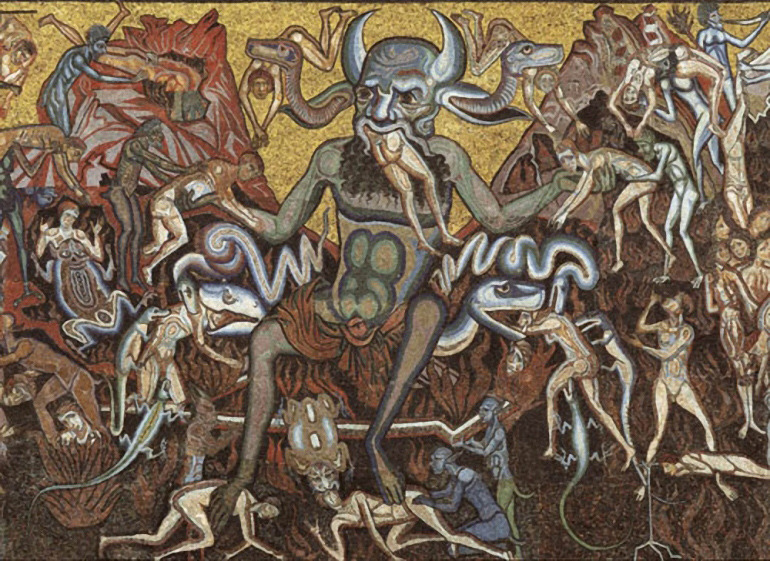When he finally stepped onstage, Langdon received a
rousing round of applause from a crowd that
was standing room only.
“Meine
Damen und Herren,” Langdon began, his
voice booming over the loudspeakers.
“Willkommen,
bienvenue, welcome.”
The famous line from Cabaret drew appreciative laughter from the crowd.
“I’ve been informed that our audience tonight contains
not only Dante Society members, but also
many visiting scientists and students who may be
exploring Dante for the first time. So, for those in
the audience who have been too busy studying to read
medieval Italian epics, I thought I’d begin with
a quick overview of Dante—his life, his work, and why
he is considered one of the most influential
figures in all of history.”
More applause.
Using the tiny remote in his hand, Langdon called up a
series of images of Dante, the first being
Andrea del Castagno’s full-length portrait of the poet
standing in a doorway, clutching a book of
philosophy.
“Dante Alighieri,” Langdon began. “This Florentine
writer and philosopher lived from 1265 to
1321. In this portrait, as in nearly all depictions,
he wears on his head a red cappuccio—a
tight-fitting,
plaited hood with earflaps—which, along with his
crimson Lucca robe, has become the most widely
reproduced image of Dante.”
Langdon advanced slides to the Botticelli portrait of
Dante from the Uffizi Gallery, which stressed
Dante’s most salient features, a heavy jaw and hooked
nose. “Here, Dante’s unique face is once again
framed by his red cappuccio, but in this instance Botticelli has added a laurel
wreath to his cap as a
symbol of expertise—in this case in the poetic arts—a
traditional symbol borrowed from ancient
Greece and used even today in ceremonies honoring poet
laureates and Nobel laureates.”
Langdon quickly scrolled through several other images,
all showing Dante in his red cap, red tunic,
laurel wreath, and prominent nose. “And to round out
your image of Dante, here is a statue from the
Piazza di Santa Croce … and, of course, the famous
fresco attributed to Giotto in the chapel of the
Bargello.”
Langdon left the slide of Giotto’s fresco on the
screen and walked to the center of the stage.
“As you are no doubt aware, Dante is best known for
his monumental literary masterpiece—The
Divine
Comedy—a brutally vivid account of
the author’s descent into hell, passage through purgatory,
and eventual ascent into paradise to commune with God.
By modern standards, The Divine Comedy
has nothing comedic about it. It’s called a comedy for
another reason entirely. In the fourteenth
century, Italian literature was, by requirement,
divided into two categories: tragedy, representing high
literature, was written in formal Italian; comedy,
representing low literature, was written in the
vernacular and geared toward the general population.”
Langdon advanced slides to the iconic fresco by
Michelino, which showed Dante standing outside
the walls of Florence clutching a copy of The
Divine Comedy. In the background, the
terraced
mountain of purgatory rose high above the gates of
hell. The painting now hung in Florence’s
Cathedral of Santa Maria del Fiore—better known as Il
Duomo.
“As you may have guessed from the title,” Langdon
continued, “The Divine Comedy was written in
the vernacular—the language of the people. Even so, it
brilliantly fused religion, history, politics,
philosophy, and social commentary in a tapestry of
fiction that, while erudite, remained wholly
accessible to the masses. The work became such a
pillar of Italian culture that Dante’s writing style
has been credited with nothing less than the
codification of the modern Italian language.”
Langdon paused a moment for effect and then whispered,
“My friends, it is impossible to overstate
the influence of Dante Alighieri’s work. Throughout
all of history, with the sole exception perhaps of
Holy Scripture, no single work of writing, art, music,
or literature has inspired more tributes,
imitations, variations, and annotations than The
Divine Comedy.”
After listing the vast array of famous composers, artists,
and authors who had created works based
on Dante’s epic poem, Langdon scanned the crowd. “So
tell me, do we have any authors here tonight?”
Nearly one-third of the hands went up. Langdon stared
out in shock. Wow, either this is the most
accomplished
audience on earth, or this e-publishing thing is really taking off.
“Well, as all of you authors know, there is nothing a
writer appreciates more than a blurb—one of
those single-line endorsements from a powerful
individual, designed to make others want to buy your
work. And, in the Middle Ages, blurbs existed, too.
And Dante got quite a few of them.”
Langdon changed slides. “How would you like to have this on your book jacket?”
Ne’er walked the earth a greater man than he.
—Michelangelo
A murmur of surprise rustled through the crowd.
“Yes,” Langdon said, “that’s the same Michelangelo you
all know from the Sistine Chapel and the
David. In addition to being a master painter and sculptor,
Michelangelo was a superb poet, publishing
nearly three hundred poems—including one titled
‘Dante,’ dedicated to the man whose stark visions
of hell were those that inspired Michelangelo’s Last
Judgment. And if you don’t believe
me, read the
third canto of Dante’s Inferno
and then visit the Sistine Chapel;
just above the altar, you’ll see this
familiar image.”
Langdon advanced slides to a frightening detail of a
muscle-bound beast swinging a giant paddle at
cowering people. “This is Dante’s hellish ferryman,
Charon, beating straggling passengers with an
oar.”
Langdon moved now to a new slide—a second detail of
Michelangelo’s Last Judgment—a
man
being crucified. “This is Haman the Agagite, who,
according to Scripture, was hanged to death.
However, in Dante’s poem, he was crucified instead. As
you can see here in the Sistine Chapel,
Michelangelo chose Dante’s version over that of the
Bible.” Langdon grinned and lowered his voice to
a whisper. “Don’t tell the pope.”
The crowd laughed.
“Dante’s Inferno created a world of pain and suffering beyond all
previous human imagination, and
his writing quite literally defined our modern visions
of hell.” Langdon paused. “And believe me, the
Catholic Church has much to thank Dante for. His Inferno
terrified the faithful for centuries,
and no
doubt tripled church attendance among the fearful.”
Langdon switched the slide. “And this leads us to the
reason we are all here tonight.”
The screen now displayed the title of his lecture: DIVINE
DANTE: SYMBOLS OF HELL.
“Dante’s Inferno is a landscape so rich in symbolism and iconography
that I often dedicate an entire
semester course to it. And tonight, I thought there
would be no better way to unveil the symbols of
Dante’s Inferno than to walk side by side with him … through the gates
of hell.”
Langdon paced out to the edge of the stage and
surveyed the crowd. “Now, if we’re planning on
taking a stroll through hell, I strongly recommend we
use a map. And there is no map of Dante’s hell
more complete and accurate than the one painted by
Sandro Botticelli.”
He touched his remote, and Botticelli’s forbidding Mappa
dell’Inferno materialized before the
crowd. He could hear several groans as people absorbed
the various horrors taking place in the funnelshaped
subterranean cavern.
“Unlike some artists, Botticelli was extremely
faithful in his interpretation of Dante’s text. In fact,
he spent so much time reading Dante that the great art
historian Giorgio Vasari said Botticelli’s
obsession with Dante led to ‘serious disorders in his
living.’ Botticelli created more than two dozen
other works relating to Dante, but this map is his
most famous.”
Langdon turned now, pointing to the upper left-hand
corner of the painting. “Our journey will begin
up there, aboveground, where you can see Dante in red,
along with his guide, Virgil, standing outside
the gates of hell. From there we will travel downward,
through the nine rings of Dante’s inferno, and
eventually come face-to-face with …”
Langdon quickly flashed to a new slide—a giant
enlargement of Satan as depicted by Botticelli in
this very painting—a horrific, three-headed Lucifer
consuming three different people, one in each
mouth.
The crowd gasped audibly.
“A glance at coming attractions,” Langdon announced.
“This frightening character here is where
tonight’s journey will end. This is the ninth ring of
hell, where Satan himself resides. However …”
Langdon paused. “Getting there is half the fun, so
let’s rewind a bit … back up to the gates of hell,
where our journey begins.”
Langdon moved to the next slide—a Gustave Doré
lithograph that depicted a dark, tunneled
entrance carved into the face of an austere cliff. The
inscription above the door read: ABANDON ALL
HOPE, YE WHO ENTER HERE.
“So …” Langdon said with a
smile. “Shall we enter?”
Dan Brown - Inferno
Přeložte tučně vyznačené části textu a vložte svůj překlad do komentáře k tomuto blogu (do nedělního večera).
zajímavý odkaz
Přeložte tučně vyznačené části textu a vložte svůj překlad do komentáře k tomuto blogu (do nedělního večera).
zajímavý odkaz

